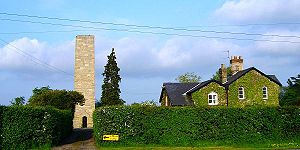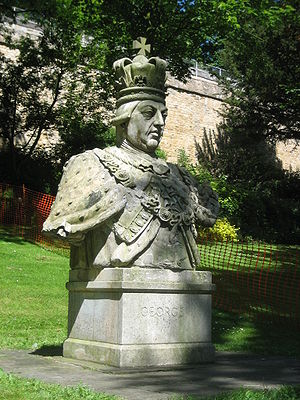
Dunston Pillar
Encyclopedia


Lincolnshire
Lincolnshire is a county in the east of England. It borders Norfolk to the south east, Cambridgeshire to the south, Rutland to the south west, Leicestershire and Nottinghamshire to the west, South Yorkshire to the north west, and the East Riding of Yorkshire to the north. It also borders...
, England
England
England is a country that is part of the United Kingdom. It shares land borders with Scotland to the north and Wales to the west; the Irish Sea is to the north west, the Celtic Sea to the south west, with the North Sea to the east and the English Channel to the south separating it from continental...
and a former 'land lighthouse
Land lighthouse
A land lighthouse is simply a lighthouse constructed to aid navigation over land, rather than water. Historically, they were constructed in areas of flatland where the featureless landscape and prevailing weather conditions might cause travellers to become easily disorientated and lost...
'. It stands beside the A15 road approximately 10 km (6 mi) south of Lincoln near the junction of the B1178 (also known as Tower Lane), in the village of Dunston
Dunston, Lincolnshire
Dunston is a small village in the North Kesteven district of Lincolnshire, England. It lies close to the B1188 between Nocton to the north and Metheringham to the south.In Domesday the village is written as Dunestune, meaning "Dune's farm"....
.
History
The original land lighthouse was commissioned by Sir Francis Dashwood (better known as the founder of the Knights of St. Francis, which became the Monks of Medmenham, later called a Hellfire Club) in 1751 as a gift to his wife Sarah (Ellys) Dashwood, who feared crossing the dark heath near her childhood home, Nocton. The purpose of the land lighthouse was to improve the safety of 18th century travellers crossing a particularly treacherous area of the county known for its many incidents of highway robbery (including a number believed to have been carried out by the notorious highwaymanHighwayman
A highwayman was a thief and brigand who preyed on travellers. This type of outlaw, usually, travelled and robbed by horse, as compared to a footpad who traveled and robbed on foot. Mounted robbers were widely considered to be socially superior to footpads...
, Dick Turpin
Dick Turpin
Richard "Dick" Turpin was an English highwayman whose exploits were romanticised following his execution in York for horse theft. Turpin may have followed his father's profession as a butcher early in life, but by the early 1730s he had joined a gang of deer thieves, and later became a poacher,...
).
The structure originally stood 30 metres high (90 ft) with a large octagonal lantern on top of the tower. The lantern was regularly lit until 1788 and was used for the last time in 1808 by which time improvements in the local road network had effectively made it obsolete.
Sir Francis landscaped the base of Dunston Tower with a plantation of trees, and a bowling green. It became a popular gathering place for picnics, tea parties, quoits and cards. A two story dining hall was later added. The vicar of Welbourn called it "the Vauxhall" of Lincolnshire, and The Lincoln Club was formed to arrange entertainments there.
In 1808, the lantern was destroyed in a storm and was replaced in 1810 by Earl of Buckinghamshire
Robert Hobart, 4th Earl of Buckinghamshire
Robert Hobart, 4th Earl of Buckinghamshire PC , styled Lord Hobart from 1793 to 1804, was a British Tory politician of the late 18th and early 19th century.-Background:...
, in celebration of fifty years of the king's reign, with a Lithodipyra (Coade stone
Coade stone
Lithodipyra , or Coade stone, was ceramic stoneware that was often described as an artificial stone in the late 18th and early 19th centuries. It was used for moulding Neoclassical statues, architectural decorations and garden ornaments that were both of the highest quality and remain virtually...
) bust of King George III
George III of the United Kingdom
George III was King of Great Britain and King of Ireland from 25 October 1760 until the union of these two countries on 1 January 1801, after which he was King of the United Kingdom of Great Britain and Ireland until his death...
sculpted by Joseph Panzetta for Eleanor Coade
Eleanor Coade
Eleanor Coade was a devout Baptist and remained unmarried until her death on 16 November 1821 in Camberwell Grove, Camberwell, London. Her obituary notice was published in The Gentleman's Magazine which declared her ‘the sole inventor and proprietor of an art which deserves considerable notice’...
.
In 1940, the pillar was considered to be a hazard to low-flying aircraft approaching nearby RAF Coleby Grange
RAF Coleby Grange
RAF Coleby Grange was a Royal Air Force station situated alongside the western edge of the A15 on open heathland between the villages of Coleby and Nocton Heath and lying due south of the county town Lincoln, Lincolnshire, England....
, and was thus lowered by 10 metres to reduce the risk of accident. At this time the bust of King George III was removed and can now be seen in the grounds of Lincoln Castle
Lincoln Castle
Lincoln Castle is a major castle constructed in Lincoln, England during the late 11th century by William the Conqueror on the site of a pre-existing Roman fortress. The castle is unusual in that it has two mottes. It is only one of two such castles in the country, the other being at Lewes in Sussex...
.
The tower remains a well-known landmark
Landmark
This is a list of landmarks around the world.Landmarks may be split into two categories - natural phenomena and man-made features, like buildings, bridges, statues, public squares and so forth...
and to this day is clearly visible beside the busy road at

